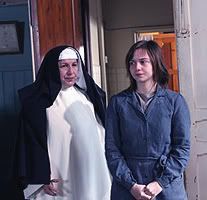 |
All the righteous people are now condemning this poor Jewish couple.
Oprah has already made a fool of herself once before with James Frey, who apparently doctored his memoirs to sell his book. I was at the cashier at Chapters buying a book when the woman beside me asked for Frey's book. I was intrigued by the title - A Million Little Pieces - and asked her what it was all about. "It's an Oprah Book!", she says hyperbolically.
"But what's it about?" I ask again.
"Oh, about a guy who overcomes his drug addiction."
I laughed a little, and let it pass. An Oprah book? And what a boring subject (and possibly full of strategies to tug at our hearts. No thanks.)
When I heard of the dupe, I actually laughed aloud. But then, I felt sorry for the guy. He seemed a pretty sharp, clever guy, who nonetheless didn't quite manage to think it all the way through (i.e., what if he ever got found out?)
Then, Oprah was really nasty to him. Rather than let it drop, she brought him back to her show (he had to be there, for his future "career", and sure enough he's written another book; fiction this time), and just berated him. He sat there and took it all in.
So, now, she's done it again. Who is she, anyway, to bring such undue notice and publicity to this couple? Doesn't she realize that her behavior can also have negative effects on people? She wished for a "love story", and she got it, at the expense of an elderly couple.
The story is more poignant than that, as far as the truth has been discerned. And at this moment, there is no more reason to doubt these details that have come up.
This particular love story actually took shape after Rosenblat was injured by gunfire during a burglary in the 1990s, and Oprah had him on her show after he won a newspaper contest for "the most romantic story". He then appeared on her show at least one other time.
Rosenblat references his mother's influence twice while telling his story. Once, to say that it was his mother who had sent him the "angel" to give him food at the concentration camp. And again, when he was recovering in hospital from the gun shot wounds, his mother (who had died in the Holocaust) came to him in a vision, telling him to share his love story with the world.
This all sounds like a man slightly overwhelmed by his circumstances, who perhaps pays an inordinate amount of attention to his mother's "voices". I daren't say he might be a little affected mentally, but that seems to be the case. He obviously has a loving wife, who might also be trying to protect him.
It was sad to see their simple, daily, life overrun by all this recent publicity. If I were Oprah and her ilk, I would have just let it die off quietly. In their craving for high romance, they pounced on this couple instead.
This tells you a thousand times more about Oprah, and those incessantly hunting publishers and film producers, than it does about the intent of the elderly Mr. Rosenblat.
I believe he meant it when he said that he just wanted to make people happy. And it looks like he really loves his wife too (and she him). What better way to please her than to make theirs the most beautiful love story ever told. And what better way for her to love him than to accept it.





















